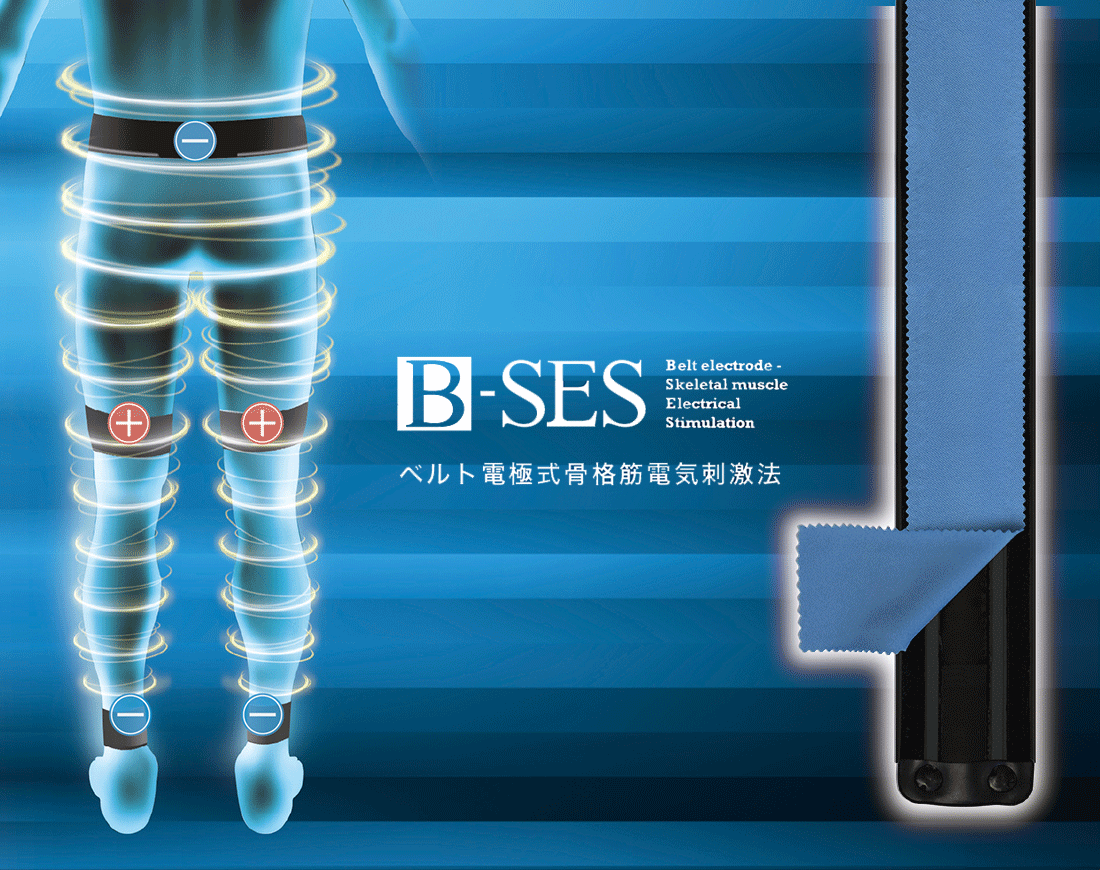


 が医療スタッフをサポートいたします!
が医療スタッフをサポートいたします!
 は医療スタッフ・患者に負担をかけず
は医療スタッフ・患者に負担をかけず
痛みや麻痺など、十分な筋収縮が行えない患者に
安全に寝たままでリハビリテーションが行えます。
 導入のメリット
導入のメリット重症患者やリハビリに難渋する様々なケースで筋トレや関節周りの筋肉を動かすウォーミングアップ運動などが行える
意識障害や認知機能の低下がある患者にも筋トレが行える
重症患者の状態に合わせて負荷量を調節し、運動量が確保できる
セラピスト以外のスタッフで、病棟でのトレーニングが増やせる
筋トレと関節周りの筋肉を動かすウォーミングアップ運動を併せて効率的に行える
 は寝たまま座ったままでも安全に運動できる
は寝たまま座ったままでも安全に運動できる

20Hzで筋肉を強縮させ強い筋収縮を行い、
随意運動における筋力トレーニングを目的とした
運動を行う。
4Hzで単収縮を繰り返し行い、随意運動における
有酸素運動を目的とした運動を行う。
「B-SES」の筋収縮の様子を動画でご紹介しています。


ベルト式電極は
下肢全ての筋肉を動かし
随意運動を代用
電極の面積が広く、皮膚の接触面積が大きくなることで電位密度が分散され、電極の痛みを感じません。
痛みを感じず、高強度での筋収縮も行えます。




電極の面積が広く、皮膚の接触面積が大きくなり、電位密度が分散されるので、電気刺激特有の痛みが感じにくいです。よって、皮膚の痛みにとらわれず、高強度での筋収縮が行えます。
電極が大きいため、モーターポイントを気にする必要がなく、装着が簡単で治療の再現性があります。

パッド式電極

ベルト式電極
ベルトとベルトで挟まれた筋肉全体に 電気を流すことができます。
モーターポイント:神経筋接合部の密集場所であり筋肉を動かす通電ポイント。
 がサポートできること
がサポートできること「 」は、ベッドに寝た状態でも
」は、ベッドに寝た状態でも
安全に運動が行えます
「B-SES」を採用することにより、有酸素運動から筋トレまで、
症例に合わせた運動をベッド上で安全に実施することができます。
従来のアプローチに難渋してきた患者への
もう1つの選択肢となる可能性があります。
自信のある医療機器だからこそ
まずはご体験いただきたい
 無料貸し出し実施中
無料貸し出し実施中
貸し出しする前に、1時間程度のデモンストレーションを行わせていただき
使い方等ご説明いたしますので、ご安心ください。
医療スタッフ・患者に負担をかけない透析中の運動サポート「G-TES」を
ぜひこの機会にご体験ください。
1,Department of Orthopaedic Surgery, Kanazawa University, Graduate School of Medicine
2,Department of Nuclear Medicine/Biotracer Medicine, Kanazawa University
3,Kanazawa Advanced Medical Center
Journal of Orthopaedic Science
Volume 21, Issue 1, January 2016, Pages 53-56
DOI:https://doi.org/10.1016/j.jos.2015.09.003
1,Department of Physical Therapy, School of Rehabilitation, Hyogo University of Health Sciences
2,Rehabilitation Center, Yodogawa Christian Hospital
3,Department of Physical Therapy, School of Rehabilitation
4,Graduate School of Human and Environmental Studies, Kyoto University,
European Journal of Sport Science Volume 16, 2016 - Issue 8,Pages 1104-1110
| Published online: 01 Mar 2016
DOI:https://doi.org/10.1080/17461391.2016.1151944
1,Institute of Biomedical Sciences (Health Sciences), Nagasaki University
2,Department of Rehabilitation, Nagasaki University Hospital
3,Department of Physical Therapy Science, Nagasaki University Graduate School of Biomedical Sciences
4,Department of Rehabilitation, Japanese Red Cross Nagasaki Genbaku Hospital
5,Department of Rehabilitation, Nagasaki Memorial Hospital
6,Research and Development Division, HOMER ION Co., Ltd.,
7,Medical Engineering Research Laboratory, ALCARE Co., Ltd.,
PLoS ONE16(5): e0244120,2021 Published: May 13, 2021
https://doi.org/10.1371/journal.pone.0244120
1,Institute of Biomedical Sciences (Health Sciences), Nagasaki University 2,Department of Physical Therapy
Science, Nagasaki University Graduate School of Biomedical Sciences
3,Department of Physical Therapy, School of Rehabilitation Sciences, Seirei Christopher University
4,Department of Rehabilitation, Nagasaki University Hospital
5,Department of Rehabilitation, Jyuzenkai Hospital
6,Department of Rehabilitation, The Japanese Red Cross Nagasaki Genbaku Hospital
PLoS ONE 17(9): e0275175,2022 Yuichiro Honda et al. Published: September 23, 2022
DOI:https://doi.org/10.1371/journal.pone.0275175
1,Department of Rehabilitation, Nagasaki Memorial Hospital
2,Department of Physical Therapy Science, Nagasaki University Graduate School of Biomedical Sciences
3,Department of Rehabilitation, Nagasaki University Hospital
4,Department of Rehabilitation, Nagasaki Genbaku Hospital
5,Institute of Biomedical Sciences, Nagasaki University
Health, 2019, 11, 1072-1086 Hideki Kataoka et al.
https://doi.org/10.4236/health.2019.118084
1,Department of Rehabilitation Medicine, The Jikei University Katsushika Medical Center
2,Division of Nephrology and Hypertension, The Jikei University Katsushika Medical Center
Artificial Organs 2018, 42(9):899-910, Tadashi.Suzuki et al.
DOI:https://doi.org/10.1111/aor.13161
1,Department of Internal Medicine & Rehabilitation Science, Disability Sciences, Tohoku University Graduate School of Medicine
2,Hirayama Hospital
3,Faculty of Health Sciences, Tsukuba University of Technolog
4,Teikyo University Graduate School of Public Health
5,Yamagata Prefectural University of Health Sciences
Journal of Clinical Medicine 2022, 11(20),6170, Midori Homma et al.
DOI:https://doi.org/10.3390/jcm11206170
1,Department of Physical Therapy, Oita Oka Hospital
2,Nagasaki University Graduate School of Biomedical Sciences
The International Journal of Lower ExtremityWounds(2022) 1-8, Shinsuke Imaoka et al.
DOI:https://doi.org/10.1177/153473462210774
1,Department of Rehabilitation, Nagoya University Hospital
2,Department of Rehabilitation, School of Allied Health Sciences, Kitasato University
3,Department of Rehabilitation, School of Allied Health Sciences, Kitasato University,
4,Department of Cardiovascular Biology and Medicine, Juntendo University Graduate School of Medicine
5,Cardiovascular Respiratory Sleep Medicine, Juntendo University Graduate School of Medicine
6,Department of Rehabilitation, Kitasato University Medical Center
7,Department of Rehabilitation, Kameda Medical Center
8,Department of Rehabilitation, Kitasato University Hospital
9,Department of Physical Therapy, School of Rehabilitation, Hyogo University of Health Sciences
10,Department of Rehabilitation Sciences, Graduate School of Medical Sciences, Kitasato University
11,Research Fellow of Japan Society for the Promotion of Science
12,Department of Cardiovascular Medicine, Kitasato University School of Medicine
13,Department of Rehabilitation, School of Allied Health Sciences, Kitasato University
14,Department of Cardiovascular Medicine, Kitasato University Medical Center
15,Department of Cardiovascular Medicine, Niigata University School of Medical and Dental Sciences
16,Department of Cardiovascular Medicine, Kitasato University School of Medicine Kanagawa
European Journal of Preventive Cardiology (2022) 29, e286‒e288,
Shinya Tanaka et al.
DOI:https://doi.org/10.1093/eurjpc/zwac022
1,Department of Rehabilitation, Nagoya University Hospital
2,Department of Rehabilitation, School of Allied Health Sciences, Kitasato University
3,Department of Rehabilitation Sciences, Graduate School of Medical Sciences, Kitasato University
4,Department of Cardiovascular Biology and Medicine, Juntendo University Graduate School of Medicine
5,Department of Rehabilitation, Kitasato University Medical Center
6,Department of Rehabilitation, Kameda Medical Center
7,Department of Rehabilitation, Kitasato University Hospital
8,Department of Physical Therapy, School of Rehabilitation, Hyogo University of Health Sciences
9,Research Fellow of Japan Society for the Promotion of Science
10,Department of Cardiovascular Medicine, Kitasato University School of Medicines
11,Department of Cardiovascular Medicine, Kitasato University Medical Center
12,Department of Cardiovascular Medicine, Niigata University School of Medical and Dental Sciences
Journal of Cardiovascular Development Disease (2022) 9,4,99 Shinya Tanaka et al.
DOI:https://doi.org/10.3390/jcdd9040099
1, Department of Physical Therapy, School of Rehabilitation, Hyogo University of Health Sciences
2,Department of Diabetes and Endocrinology, Kobe City Medical Center General Hospital
3,Nutrition Management Department, Kobe City Medical Center General Hospital
4,Graduate School of Human and Environmental Studies, Kyoto University
Diabetes Research and Clinical Practice 142(2018) 37-45, Toshiaki Miyamoto et al.
DOI: https://doi.org/10.1016/j.diabres.2018.05.032
上記以外のエビデンスについてはお問い合わせください。
 をご利用いただいています!
をご利用いただいています!掲載しきれない施設もございます。 の導入先や運用方法については、お問い合せください。
の導入先や運用方法については、お問い合せください。
 仕様
仕様| 種別 | 理学診療用器具低周波治療器 (特定保守管理医療機器:クラスⅡ) |
|---|---|
| 認証番号 | 228AGBZX00036000 |
| 型番 | G-TES 2000GC |
| 本体寸法 質量 付属品 |
幅365×奥行222×高さ103[mm] 約2.2[kg]〈本体〉 ベルト電極〈小2本、中2本、大1本〉 ベルト電極用接続ケーブル 2本 中継ケーブル5本(グレー1本、オレンジ2本、パープル2本) パッド導子〈マイナス側2個、プラス側1個〉 パッド導子固定用バンド〈大1本、小2本〉 抗菌通電液クリーンパワー〈1本〉 専用SDカード〈1枚〉 |
| カート寸法 質量 |
幅490±50x奥行490±50x高さ860±50[mm] (ケーブルガイドアーム除く) 約24[kg] (ケーブルガイドアーム含む) |
| 定格電源電圧 | 100-240[V]〈50-60Hz〉 |
| 電源入力 | 2.0-1.5[A]A |
| 電撃に対する 保護の形式 |
クラスⅠ |
| 電撃に対する 保護の程度に よる装着部の 分類 |
BF形装着部 |
| 最大出力電圧 | 138[V]±10%(500Ω負荷接続時) |
| 最大出力電流 | 48[mA]±10%(500Ω負荷接続時) |
| 出力波形 | 指数関数的漸増波 |
| パルス幅 | 56-260μsec±10% |
| タイマー | 最長50分±5% |
| 導子温度 | 最高41℃〈冷感緩和機能〉 |
| JMDNコード | 35372000 |
※商品改良のため予告なく一部仕様を変更することがありますので、ご了承ください。
次の患者には使用しないこと。
自信のある医療機器だからこそ
まずはご体験いただきたい
 無料貸し出し実施中
無料貸し出し実施中
貸し出しする前に、1時間程度のデモンストレーションを行わせていただき
使い方等ご説明いたしますので、ご安心ください。
医療スタッフ・患者に負担をかけない透析中の運動サポート「G-TES」を
ぜひこの機会にご体験ください。
| 社名 | 株式会社ホーマーイオン研究所 |
|---|---|
| 所在地 | 〒150-0045 東京都渋谷区神泉町17番2号 |
| TEL | 03-3464-6655(代表) |
| FAX | 03-3464-6655(代表) |
| 事業内容 | 理学診療機器・家庭用治療機器・美容機器の製造販売 基礎化粧品の製造販売、低周波電気刺激の生体反応を応用し、周辺機器の開発 |